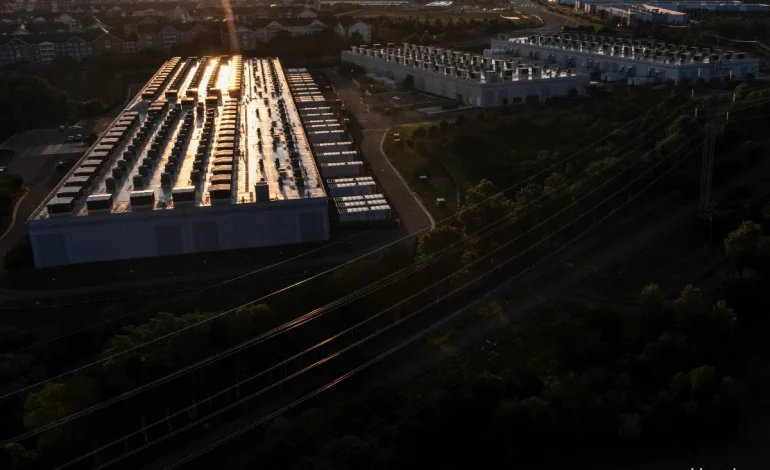
Introduction
China has begun work on a project worth 37 billion US dollars that involves transforming farmland into massive data centers to fuel its artificial intelligence ambitions. Dubbed by some observers as the “Stargate of China,” the initiative highlights the country’s determination to centralize computing power and achieve global leadership in AI despite mounting restrictions on access to advanced semiconductors.
Why farmland is being repurposed
Authorities selected rural areas for the data center buildout because of space availability, energy potential, and the need to rebalance regional development. Converting farmland into high density computing hubs reduces land pressure in cities like Beijing and Shanghai while injecting investment into less developed provinces. The strategy also reflects the government’s desire to create a more even spread of digital infrastructure across the country rather than concentrating everything in coastal regions.
The scale of the project
The 37 billion dollar budget makes this one of the largest data center undertakings in the world. Reports indicate that the facilities will house tens of thousands of high performance servers, specialized cooling systems, and renewable energy integration. The goal is to build a computing network capable of supporting large language models, generative AI platforms, and national security applications.
Officials have suggested that the data centers will be linked by high speed fiber and coordinated under a unified management system. This would allow compute resources to be allocated dynamically depending on demand, effectively creating a national cloud backbone.
Strategic timing
The decision to accelerate data center construction comes as US export controls limit China’s access to Nvidia and AMD chips. By centralizing resources, Beijing hopes to maximize efficiency and ensure that domestic alternatives can be deployed at scale. Even if individual chips are less advanced, pooling thousands of units into coordinated clusters can deliver competitive performance.
Timing also matters because AI adoption inside China is rising quickly. Startups, financial institutions, and manufacturing companies are demanding more processing power to support applications from chatbots to industrial automation. Without massive data centers, many of these companies would face bottlenecks in training and deploying AI models.
Environmental and food security questions
The conversion of farmland into data centers has sparked debate inside China. Critics worry about the loss of arable land at a time when food security is already a sensitive issue. Government planners argue that only marginal or underutilized farmland will be used and that renewable energy sources such as hydro, solar, and wind will be integrated to reduce environmental impact.
Still, the energy footprint of AI data centers is enormous. Cooling systems and servers consume vast amounts of electricity and water. If not carefully managed, the project could strain local resources and undermine Beijing’s climate commitments.
Regional development impact
On the positive side, the project is expected to generate jobs and attract skilled workers to rural provinces. Local governments see data centers as anchors for wider digital ecosystems, encouraging investment in fiber networks, logistics, and AI training institutes. For communities that previously relied on agriculture, the arrival of high tech infrastructure could transform economic prospects.
The initiative is also being tied to broader efforts to reduce the digital divide. By locating data centers in inland areas, authorities hope to make advanced computing resources accessible to universities, startups, and small businesses far from the coastal hubs.
Integration with national AI strategy
China has set a goal of becoming the world leader in artificial intelligence by 2030. The farmland conversion project is part of the so called “Eastern Data, Western Computing” plan, which seeks to shift computing workloads from crowded eastern cities to the west where land and energy are cheaper. The new buildout in rural areas complements this strategy and provides the backbone for scaling AI projects nationally.
Major companies such as Alibaba, Tencent, and Huawei are expected to be tenants and contributors. Their cloud divisions will lease space, provide services, and integrate their proprietary AI platforms into the new facilities. Startups may gain subsidized access to computing time, boosting innovation across the sector.
Global implications
Internationally, the project signals that China is not slowing down in the AI race. While the US and its allies tighten controls on advanced chip exports, Beijing is responding with massive infrastructure spending. The scale of the initiative sends a message that China intends to compete in AI not just through algorithms but through raw computational scale.
For global technology supply chains, this could create new demand for domestic Chinese chips and networking equipment. Companies involved in cooling systems, renewable energy integration, and fiber optic networks may also benefit. At the same time, the project highlights the divergence between Chinese and Western approaches to AI development.
Risks and challenges
There are risks beyond food security and energy consumption. Centralizing data centers also concentrates cyber security risks. A large scale outage or cyberattack could disrupt national AI capacity. Furthermore, global skepticism about data governance in China may limit international firms’ willingness to rely on Chinese data infrastructure for sensitive projects.
Financing is another challenge. Although the project is backed by government funding, sustaining such high levels of capital expenditure requires continuous returns. If AI applications do not scale as quickly as expected, some facilities could end up underutilized.
Conclusion
China’s decision to convert farmland into 37 billion dollars’ worth of data centers marks one of the most ambitious infrastructure moves in the AI era. By creating vast pools of computing power, the government hopes to secure a competitive edge in artificial intelligence and strengthen its digital economy. The plan promises jobs, innovation, and regional development, but it also raises difficult questions about land use, sustainability, and global competition. How these tensions are managed will determine whether the project becomes a model for AI driven growth or a source of controversy in the years ahea






